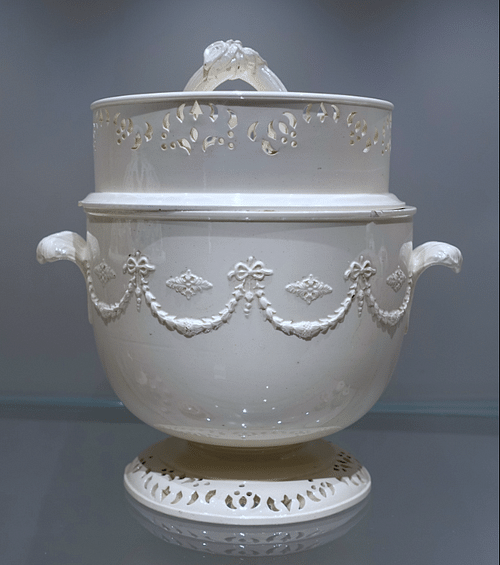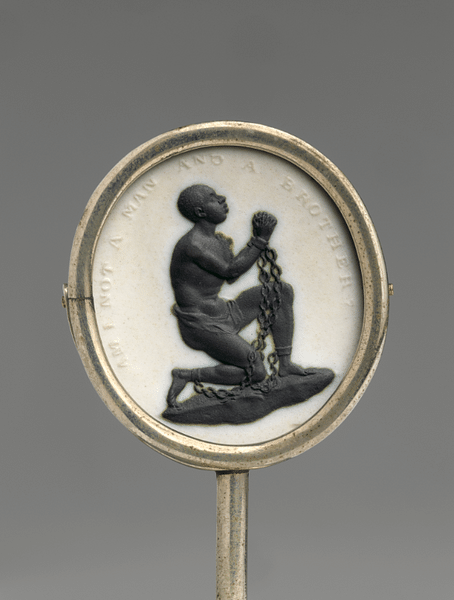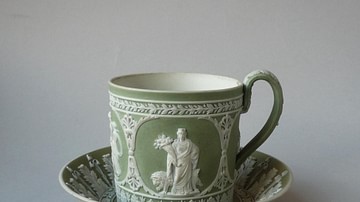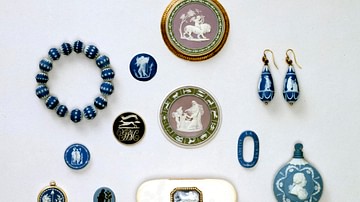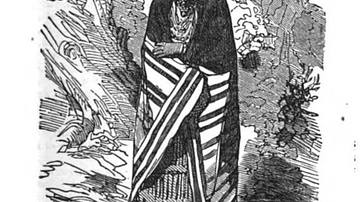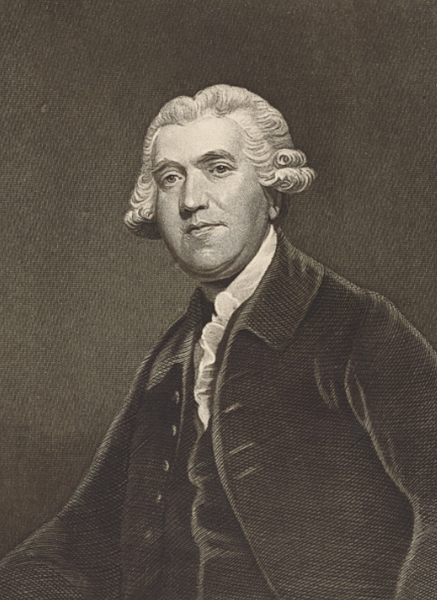
Josiah Wedgwood (1730-1795) was an English manufacturer and inventor who designed and created pottery of all kinds. Noted for his jasper stoneware, Wedgwood was also innovative in how he set up his factory works, for embracing new technology like the steam engine, and using creative sales and marketing techniques. Wedgwood pottery is still made today and remains highly collectible.
Early Life & Family
Josiah Wedgwood was born in 1730 in Burslem (now part of the city of Stoke-on-Trent) in Staffordshire, England. Josiah's father Thomas was a potter, and he came from a long line of potters. Josiah went to school at Newcastle-under-Lyme and then he learnt his pottery craft as an apprentice in what was by then his elder brother's company in Burslem, the Churchyard Pottery Works. It was in his youth that Josiah caught a bad case of smallpox, which ultimately led to the necessity of having his right leg amputated. It was during his lengthy convalescence period that Josiah studied the history, theory, and practice of pottery in all its forms, keeping an experiment book to record his findings. Leaving the family firm after his brother refused to allow him to become a full partner, Josiah worked for several other pottery companies over the next few years.
Josiah next formed a partnership with Thomas Whieldon (1719-1795), a well-respected figure in the industry. The two potters set up their business, still in Staffordshire, in 1754 and experimented with what exactly could be made using the very latest and brand-new techniques in their field. Wedgwood's experimentations with pottery lasted throughout his career, his invention of the pyrometer, a device that measured very high firing temperatures ultimately led to him becoming a Fellow of the Royal Society.
The Ivy House Factory
Josiah Wedgwood was known not only for his design flair and fine execution of pottery but also for his systematic, almost obsessive investigations into materials and processes to improve the final product. Wedgwood invented a much better green glaze than previously existed, but he was determined to go it alone and so set up his own firm back at Burslem, the Ivy House Works in 1759. Wedgwood deliberately set out to make products for those with a high level of disposable income. His prices were sometimes double of his competitors, but he wanted the rich and famous to be attracted to his products precisely because they were exclusive. The Wedgwood name would spread, and he could then sell cheaper wares to the middle classes. In 1762, Wedgwood was so successful that he needed bigger premises; he moved his business to what became known as the 'Bell' works, so called because workers were called to their stations by a bell as opposed to the traditional horn.
Wedgwood's innovative cream-coloured earthenware was a popular success both in Britain and elsewhere, even finding a royal admirer in Queen Charlotte, wife of King George III of Great Britain (r. 1760-1820). Charlotte went so far as to describe Wedgwood as the "Queen's potter". The association with the monarchy meant that Wedgwood's simple cream designs became known as Queen's ware, and the brand became well known after featuring in the popular press and monthly magazines. Wedgwood was not slow to mention the Queen as one of his customers in company advertising. By the 1760s, Wedgwood had become an international name in the field and so the works were moved to larger premises, the Brick House factory in the same town.
In January 1764, Josiah married a cousin, Sarah (often called Sally), the daughter of Richard Wedgwood who was a successful merchant operating from Burslem. The couple went on to have seven children (plus one who did not survive infancy). One daughter, Susannah, became the mother of Charles Darwin. Sarah's £4,000 dowry (nearly $700,000 today) was immediately invested into the potter's expensive experiments to find new types of wares. By the mid-18th century, Britain was awash with high-quality porcelain from China, imported by the booming British East India Company. Impressed by the hardness and translucency of fine china, Wedgwood was determined to come up with a handsome new material of his own.
Classical Influence & Etruria
Wedgwood was often inspired by Classical art, and from 1769 he partnered with the Liverpool merchant Thomas Bentley (1731-1780) to create a range of unglazed stoneware using decorative elements of Neoclassicism, a style already popular in art and architecture in Victorian Britain. The wares were made in a specialist works near Newcastle-under-Lyme which Wedgwood called Etruria, named after the area in central Italy where the Etruscan civilization had flourished between the 8th and 3rd century BCE. The Etruscans, as archaeologists were just then discovering, were great admirers of Greek pottery and fine potters themselves. Wedgwood even called his nearby private home Etruria Hall. Pompeii had just been rediscovered in 1748, and the artefacts dug up, along with pottery found in Etruscan tombs and Greece itself, created a surge in public interest in the art of the ancient world. Wedgwood immediately saw the advantages of tapping into this new love of historical art and ancient mythology.
From 1773, Wedgwood's new range of classical-inspired wares came in various colours, and they were usually non-functional objects that people could use as ornaments to decorate their homes. Three of the most popular ranges were green jasperware, light-blue jasperware, and black basalt. Various other colours could be achieved with the addition of oxides in the firing process, fruit of Wedgwood's 5,000 or more experiments using clay mixtures and glazes. Designs were made separately, usually in white, and added as a distinctive relief to these coloured wares. The applied relief sculpture was intricate and highly developed. There were also many outright sculpture pieces in Wedgwood's catalogue, such as busts, figurines, and chess sets, which were often created by such noted in-house artists as John Flaxman (who later went on to have great success with his funerary sculptures). Another ancient source of inspiration was Greek black-figure pottery, with Wedgwood creating a black-on-red range of wares.
Sometimes, Wedgwood directly copied noted works of antiquity. A famous example, rendered in black and then lighter blue jasperware, was the Portland Vase, one of the masterpieces of ancient Roman art. The original vase is a two-handled glass amphora made sometime between the second half of the 1st century BCE and the early 1st century CE. The vase has a cameo-like effect decoration which perhaps depicts the marriage of Peleus and Thetis from Greek mythology. Wedgwood's versions were made from 1786 onwards.
A Master of Marketing
An indication of Wedgwood's success in Europe was the creation of imitation styles by established pottery works such as Meissen in Germany and Sèvres in France, the former even called their range of glazed jasperware Wedgwoodarbeit. Perhaps Wedgwood's greatest-ever sale was to Catherine the Great of Russia (l. 1729-1796), who in 1774 bought a fine service set consisting of around 950 pieces. This incredible set was called the Frog Service after the green frog crest that appears on each piece in homage to the palace Catherine wished to use it in. Most of the items featured a hand-painted scene of English life. Wedgwood was a clever marketer, and he first displayed the Frog Service in a ticket-only exhibition in London before sending it on to Russia.
Wedgwood sent fine dinner sets to many royal houses and British ambassadors around Europe so that when they held dinner parties, their guests would see the prominent Wedgwood logo. Another strategy was to open elegant showrooms, first in London and then in other major cities. These showrooms were spacious affairs where the wonder of entire service sets featuring hundreds of items could be displayed complete. Wedgwood lobbied Parliament to favour his export trade, becoming a prominent member of the General Chamber of Manufacturers. The focus on exports and sending out hundreds of sale or return samples was an expensive undertaking, but it reaped huge rewards. By the 1780s, around 80% of Wedgwood's sales were outside Britain.
Wedgwood used several sales techniques to encourage wavering buyers: "He offered free carriage of his goods anywhere in the country, a money-back guarantee for dissatisfied customers, and free replacement for breakages" (Dugan, 57). Another new idea of Wedgwood's to boost sales of his wares was to send salesmen around Britain, Europe, and the United States, further cementing his place as the most fashionable and well-known of all pottery manufacturers. As Wedgwood himself noted, "Fashion is infinitely superior to merit" (Horn, 82). Josiah Wedgwood, then, combined ancient art and iconography with the very latest pottery production techniques to create what we would today call a designer label.
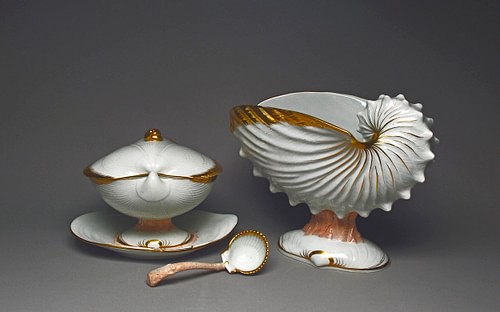
An Innovative Factory
The Etruria works were innovative in many ways besides the products made. The factory was purposely located just by the new Trent and Mersey Canal, a construction project that Wedgwood himself had been heavily involved in. The canal meant that raw materials like superior clay from the United States could be shipped in by barge and finished products passed out again with great ease. Waterways were particularly important for pottery manufacturers since, at the time, transporting such delicate goods by road often led to a high number of breakages.
Another important feature of Etruria was Wedgwood's reorganization of traditional working practices. Previously, one multi-skilled worker created one piece of pottery. Now, several workers each did their own work on a single piece in a predefined sequence that moved the item through the factory in stages. This was the first pottery works in Europe to use an assembly line. As a consequence, Wedgwood did not need to find workers skilled in all areas of the manufacturing process but only those with enough skill to perform their particular task. This meant that making such decorative pottery became cheaper since a craftsman skilled in all aspects was difficult to find and expensive. A disadvantage for the workers was that they had a very repetitive job and no artistic satisfaction from having personally seen an item through its various stages to completion.
In 1772, Etruria had a steam engine installed, and there was an engine-turned-lathe, as Wedgwood embraced the latest technology of the Industrial Revolution. Continuing to innovate as an employer, too, Wedgwood created a village for his workers and their families. The housing was convenient for everyone, but, since Wedgwood retained ownership of the properties, it did also give the employer a level of control over his employees not seen before in industry. On the other hand, Wedgwood did pay his workers well.
The Etruria factory was now producing all manner of items in pottery, everything from cameo brooches to large ornamental pedestals. The company continued to manufacture both fine dinner services and wares for everyday use along with decorative objects, but Wedgwood was willing to make anything that was fashionable and seemed capable of selling well. Wedgwood even used his pottery skills to promote causes important to him. He was a member of the Unitarian Church and, against slavery, he financially supported the Society for Effecting the Abolition of the Slave Trade, founded in 1787. The same year, Wedgwood had a jasperware cameo medallion made to promote the cause. Known as the Slave Medallion, it showed a kneeling and enchained slave with the words "Am I not a man and a brother?" Thousands of the medallions were made, and many were bought by wealthy anti-slavery activists who then gave them out to supporters. Britain did finally abolish the slave trade in most of its territories in 1807.
With booming sales all over the world, the future of the Wedgwood name was assured, and it survived the death of its founder. Josiah Wedgwood died on 3 January 1795, his son and nephew continued his legacy, and Wedgwood still makes decorative pottery items today, many of which have become a favourite of collectors.
